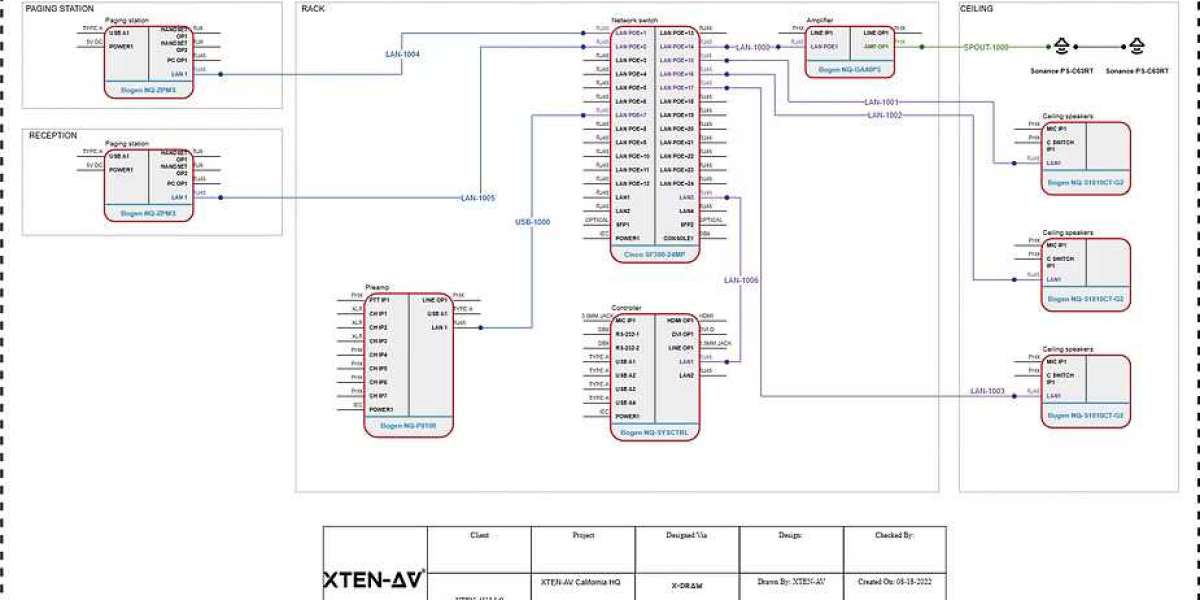XTEN-AV is reshaping the landscape of AV system design by offering solutions tailored specifically for AV professionals. While traditional CAD software has been a mainstay for architects and engineers, it often falls short for the unique needs of audio visual projects. AV system design is more than just floor plans and structural layouts; it involves precise equipment placement, signal routing, rack optimization, and collaboration with multiple stakeholders. In this blog, we’ll explore what AV professionals need in a true AV CAD tool and why specialized platforms are essential for delivering efficient, accurate, and innovative AV designs.
Step 1. Pre-Built AV Libraries and Components
One of the most critical features of a true AV CAD tool is access to comprehensive libraries of AV equipment. AV professionals rely on projectors, screens, displays, speakers, microphones, control systems, and racks. Traditional CAD platforms often require designers to create these components from scratch, which is time-consuming and prone to errors.
A true AV CAD tool, like XTEN-AV, provides pre-built and up-to-date equipment libraries. Designers can drag and drop devices directly into their layouts, ensuring accurate representation of each component. This not only saves time but also reduces the chance of mistakes in specifications and procurement.
Step 2. Signal Flow Integration
Signal flow is the backbone of AV system design. Audio, video, and control signals must be routed efficiently and accurately. Non-specialized CAD platforms focus primarily on spatial layouts and offer limited support for visualizing signal flow.
AV professionals need a CAD tool that allows them to map and manage signal paths directly within the design environment. XTEN-AV integrates signal flow diagrams with equipment placement, enabling designers to detect potential issues early and streamline the installation process.
Step 3. Rack and Equipment Optimization
Racks are central to AV systems, housing multiple devices that require precise placement, ventilation, and power management. Traditional CAD software lacks features to optimize rack layouts, often forcing designers to manually calculate space and check clearances.
A true AV CAD tool automates rack optimization, ensuring proper placement, airflow, and power distribution. This helps reduce installation challenges and ensures that the system performs reliably from day one.
Step 4. Real-Time Collaboration
AV projects typically involve multiple teams, including integrators, consultants, architects, and project managers. Real-time collaboration is essential to keep projects on schedule and maintain consistency across designs.
Non-specialized CAD tools often require file sharing and manual version control, which increases the risk of errors and miscommunication. XTEN-AV offers cloud-based collaboration, allowing multiple users to work on the same project simultaneously, with instant updates and automatic version tracking.
Step 5. Automated Documentation
Accurate documentation is critical in AV projects, encompassing floor plans, signal diagrams, equipment schedules, and rack layouts. Traditional CAD tools usually require designers to manually create and compile this information, which is time-consuming and prone to inconsistencies.
A true AV CAD tool automates documentation generation. XTEN-AV can produce detailed reports and diagrams that reflect the latest project updates, saving time, reducing errors, and simplifying handoff to installation teams.
Step 6. Simulation and Performance Testing
AV system performance depends on precise placement of devices, room acoustics, and display visibility. Non-specialized CAD platforms offer limited or no support for simulating these factors.
AV professionals need built-in simulation tools to predict performance before installation. Features like speaker coverage analysis, projector throw distance, and acoustic modeling enable designers to make informed decisions and avoid costly on-site adjustments. XTEN-AV includes these simulation capabilities, helping ensure optimal system performance from the start.
Step 7. Integration with Project Management Tools
Modern AV projects often require integration with project management, inventory, and procurement systems. Without this integration, designers must manually transfer data, increasing the risk of errors and slowing down project delivery.
A true AV CAD tool should integrate seamlessly with these systems. XTEN-AV allows designers to link equipment lists, costs, and schedules with the overall project plan, improving efficiency and accuracy.
Step 8. Adaptability to New Technologies
The AV industry evolves rapidly with new devices, standards, and installation techniques. Non-specialized CAD tools may lag behind, requiring designers to manually update libraries and templates.
AV professionals need a CAD tool that stays current with industry trends. XTEN-AV regularly updates its equipment libraries and software features, ensuring that designers always have access to the latest tools and technologies.
Step 9. User-Friendly Interface and Workflow
Complexity in traditional CAD software can slow down AV design, especially for professionals who are not familiar with architectural or mechanical drafting. A true AV CAD tool should have an intuitive interface tailored to AV workflows, reducing the learning curve and allowing designers to focus on creative and technical problem-solving rather than navigation and setup.
Conclusion
AV professionals face unique challenges that traditional CAD software is ill-equipped to handle. From pre-built equipment libraries and signal flow integration to rack optimization, simulation, and real-time collaboration, specialized features are essential for delivering high-quality AV projects efficiently. XTEN-AV provides all these capabilities in a single platform, helping AV designers streamline workflows, reduce errors, and ensure project success.
Choosing the right AV CAD tool is no longer just a matter of convenience. It is a critical factor in project delivery, client satisfaction, and business growth. By leveraging specialized software like XTEN-AV, AV professionals can focus on innovation and performance, rather than battling inefficiencies inherent in non-specialized CAD platforms.
Read more: https://soundsightav.odoo.com/blog/our-blog-1/how-cad-mistakes-cost-av-businesses-thousands-100








